Appropriately apply formal and informal incident command systems to course evolutions and scenarios
A really fun and informative part of our class is the scenarios. Some will be relatively simple like yard sales, others much more complex like foot entrapments and C-Spine rescues. I often add subtle exercises as well ;-) To add some reality, we will try some role playing like having some boaters pretend they are novices and bystanders. As rescuers, you will need to be able to quickly determine which type of command structure fits the situation best and respond accordingly.
ICS - Roles
Background
Fire companies, police, and other professional first responders use a heavy weight formal Incident Command System or Unified Command. For background on this approach, refer to:
- FEMA: http://training.fema.gov/EMIWeb/IS/ICSResource/index.htm
- OSHA: https://www.osha.gov/SLTC/etools/ics/what_is_ics.html
In whitewater boating, we haven't the vast number of resources nor the set-up time to approach rescues in this manner. That said, there's a a great deal we can all learn from this well tested approach. Some key attributes of ICS are structure and great communication. One way to describe this approach is looking at various ICS roles we would commonly see in river rescues.
ICS Leader
The ICS Leader often has the most experience on the team. Major responsibilities are:
- Planning
- Oversight
- Providing Direction
- Monitoring Assets
- Communication with outside agencies (may be delegated)
To increase chances of success, the ICS Leader shouldn't be involved in the rescue itself. It's very difficult (often immpossible) to be hands on and maintain overview of the entire operation (rescue) at the same time.
ICS Safety Officer
The individual in charge of group safety also has an oversight role. In ideal situations, this individual is also hands off so they can view the entire rescue scene for potential safety issues. Here are a few of this role's responsibilities:
- Upstream safety - Ideally out of sight of the incident scene to avoid being distracted. This individual needs to be vocal and persistent at preventing others from entering the accident scene.
- Downstream Safety - This may be a mix of persons in boats and persons with throw bags on either or both shores.
- Eyes on boths sides of the accident site.
- Monitor equipment usage.
- Continually scan the entire rescue scene for potentially unsafe practices intervening when necessary.
ICS Rescue Lead
This is often a team (or multiple teams: Plan A, Plan B, etc.). Usually one individual is assigned a lead role. This is very much a hands on role. They determine the plan and direct everyone towards achieving that plan.
ICS - Other roles
- Rigger - Set's up more complex systems like Mechanical Advantage or cinches in some cases. This individual usually carries a full pin kit and has strong rescue training.
- Medic - Once the victim/s are stabilized, they may need medical attention. This individual usually carries the best First Aid Kit and also has the highest level of Wildernesss First Aid training.
- Runner - Sometimes more heavy duty assistance will be needed (like evacuation of a C-Spine injury). We often like a pair of runners. They will paddle or run to contact 911 for recue services. It's very important to rehease this pitch prior to leaving. A copy of the SOAP form goes with the runner.
- Communications Officer - This may be a second duty of the ICS Leader. This individual frees everyone else to continue in their roles and is in charge of outside communications.
- Quartermaster (Gopher) - Works with the other teams in acquiring various items they need.
Paddle Signals
Whitewater is often loud and presents a communication challenges. Many boaters carry a safety whistle so they can warn others about a very dangerous situation. This is done with 3 whistle blasts - the universal sign of danger. A single whistle blast is commonly used to catch a person's (or group) attention. Try not to overuse the whistle as this reduces its effectiveness (like the boy who cried wolf too often).
When running a difficult river, the lead boat (scout) runs the drops first and sometimes needs to quickly relay guidance back to the rest of the team. Ideally, this is done with paddle signals (or sometimes hand signals). Using the paddle is preferred since it is large and easy to see. When signaling others on which route to take, always point in the direction you want them to go - never towards the obstacle.
| Go | Stop | Direction | I'm OK | Danger | |
| Paddle | 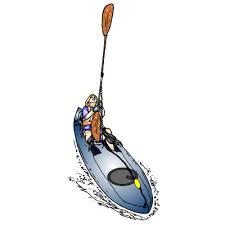 |
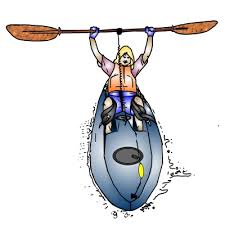 |
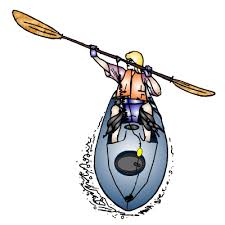 |
||
| Hand | 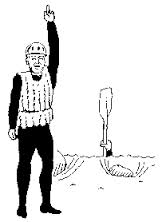 |
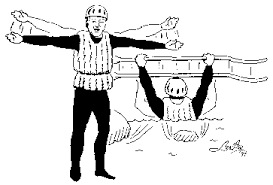 |
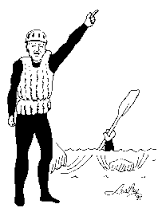 |
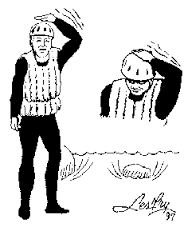 |
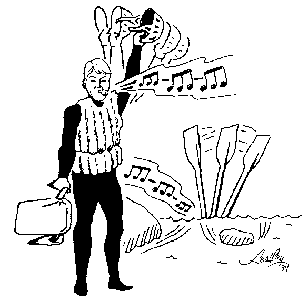 |
There are a number of other useful signals as described in this useful article: River Signals. This is another excellent site for the common signals: Common River Signals. The excellent AW Safety Article also covers universal signals.
Communication (AW signals)
Whitewater is very noisy. We typically use hand/paddle signals to communicate with boaters and rescuers. Everyone should carry a decent safety whistle. One blast means "I need your attention", three blasts is the universal distress/danger signal. What do you do if you hear two blasts? Assume you missed one and prepare to get off the river immediately: Look, Listen, Plan/Act. These days, it isn't a bad idea to carry a cell phone in a dry bag just in case. Here is a nice article on AW River Signals: AW River Signals.
Hand and whistle signals
Besides signalling with paddles while on the water, sometimes it's more convenient to communicate via hand signals. Here are some of the most common ones:
|
I'm OK
|
STOP
|
Go That Way
|
All is Clear
|
Danger with Whistle Blasts
|
Cell phone or radio if appropriate
Most commercial concerns and many fire companies carry portable hand radios. These are great for communicating back to home base for a wide variety of purposes. Most boaters don't carry these but we should seriously consider carrying a cell phone in a very waterproof container (like a Pelican Box). Even if communication is sketchy down on the river, we are often able to hike up to a higher elevation or gain access to a nearby road. In some rescues, getting the help you need quickly can be a real life saver.
Something Seriously Wrong
We try to take all necessary precautions in this class but we are in a natural environment and sometimes nature throws us a curve ball. Webbing or rope underwater, a rock moves unexpectantly, equipment malfunctions, rope crosses the body in a bad spot like my neck - anything can happen. A "For Real" signal is a opractice we use. In general, this is three of anything: 3 whistles, repeated 3 bangs, 3 chops with the hand - whatever is easiest to perform. At this point, Instructors and Safety persons will kick into gear and implement a prompt rescue.
Whistle Etiquette
In general, we avoid the use of our whistles - especially in busy parks like the C&O Canal. Use the whistle only when necessary like a real incident. Extraneous whistle usage can lead to calls to the local fire company and waste their resources.
Page 1 of 3
